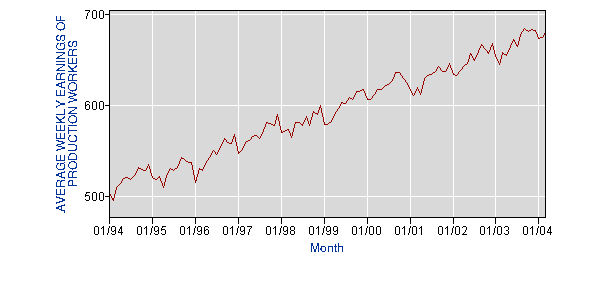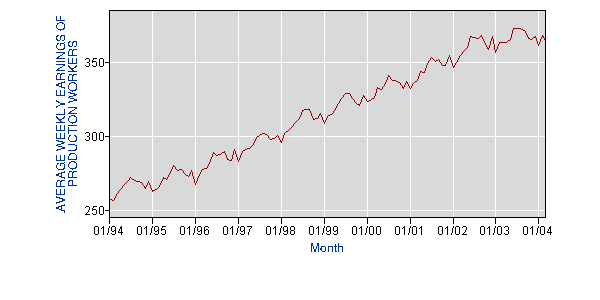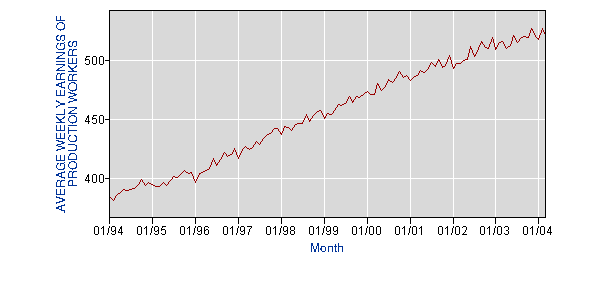The Wages of Sinners
Thursday, April 15th, 2004 London, England Dear Reader, I'd meant to talk more about the Fed's current dilemma, but ended up doing more reading than writing. Hopefully the weekend edition of SI will give a succinct version of what I've found. I'll let you know. Meanwhile, you saw more evidence today of the horns of the dilemma that Fed finds itself on. On one horn, financial assets are deflating. This is a big drag on consumer confidence and spending. You could call it psychologically deflationary. On the other horn, while producer and consumer prices are rising (victory for Greenspan?), consumer incomes are not. Consumers can't spend what they don't have (especially when they ease back on credit.) And they can spend even less when they don't have a job. Today the Labor department reported that the number of Americans filing initial jobless claims increased by 30,000 last week. It was the largest increase in more than year. What will the Fed be looking for? Well tomorrow, you'll see March housing starts and building permit figures. This won't fully reflect the effect of rising rates on housing activity. For that, you'll probably have to wait another month. But a poor number may add fuel to the equity fire. And even a good number could be a sign that the binge building that accompanied historically low interest rates may be topping out. In either case, I'd look closely at buying puts on homebuilders. I know. I know. Nearly every time I've done this in Strategic Options Alert I've been stopped out of the position for a loss. But if homebuilding stocks react to rising rates and slower housing activity the way REITS have (see the chart of the day), there could be some homerun profits. On April 26th and 17th you'll see new and existing home sales for March. It's here you'll probably start to see interest-rate related declines. The Fed will also be keeping a keen eye on the average selling prices for new and existing homes. The data for February showed that existing home prices rose 4% on year over year basis. That was less than half the double-digit pace you saw in July of last year. It's conceivable that in some areas of the country, you'll even pronounced declines in the average selling price for an existing home. What about new homes? February new home sales were up 5.8% year over year. Median prices for new homes rose 9.9% in February, although that was down from the torrid 14.4% of November. The median price of new homes is important. It-and low interest rates-provide the chief incentive for buying a house at all. If new home prices start to decline, prospective buyers are less likely to believe the canard that they can "flip" the home in a few years and trade up for a larger house. I could be wrong, of course. The Fed may be completely insensitive to the unravelling of American balance sheets as the housing market falls apart. After all, it didn't lift a finger to stop the Nasdaq from falling apart. But 68% of Americans own homes. And a loss in the value of your home probably hits, if you'll pardon the pun, closer to home, than a loss in your stock portfolio. Indeed, a loss in the value of your home might be the precursor to the loss of ownership of your home. The Fed knows this. And I suspect by the time it meets on May 4th, it will have plenty to chew on in. Namely, inflationary pressures in consumer and producer prices on the one hand, and falling housing prices and consumer incomes on the other hand. The Fed's next meeting also happens to be just a few days before the April non-farm payroll report comes out. In that report, we'll find out if the March numbers were part of a larger trend (rising employment), or a lot more hollow and ephemeral than they first appeared. We'll also find out what's going on with average hourly and weekly earnings for most Americans. As I showed last month, wage growth in retail service jobs (where most of the jobs are being added) isn't keeping up with inflation. In fact, I went back through historical date for average weekly earnings today. I wanted to compare the increase in retail weekly earnings with goods producing weekly earnings. My thesis was pretty simple: retail wages would be rising faster than goods wages. But as the economy sheds manufacturing jobs and adds retail jobs, both rates of increase wouldn't increase much nominally, and might not even keep up with inflation. Here's what I found: From 1994 to 2004, average weekly earnings in goods producing jobs grew 28%, from $519/week in 1994 to $669/week. That's an average annual increase of 2.8% per year over ten years.
 During the same period, average weekly earnings in retail trade jobs grew 38%, from $265/week in 1994 to $367/week in 2004. Even though wages here grew at a full percentage point per year faster than goods producing jobs, the average weekly income in retail jobs is still 82% below the average weekly income in a goods producing job.
During the same period, average weekly earnings in retail trade jobs grew 38%, from $265/week in 1994 to $367/week in 2004. Even though wages here grew at a full percentage point per year faster than goods producing jobs, the average weekly income in retail jobs is still 82% below the average weekly income in a goods producing job.
 And by the way, for all non-farm jobs combined, average weekly earnings grew from $390 in 1994 to $517 in 2004-a 32% increase over ten years, or 3.2% a year.
And by the way, for all non-farm jobs combined, average weekly earnings grew from $390 in 1994 to $517 in 2004-a 32% increase over ten years, or 3.2% a year.
 The point of all this? Ten years does not a long-term trend make. But wage growth in America sucks. Ask about anyone you know. You'll get the same sentiment
There are lots of roots to this thorny problem. It's not just China and India. It's higher productivity requiring fewer workers.
For example, I was able to cobble together all the data for the above analysis in about two hours. Five years ago, it would have taken me two days, if not more, and required at least two people...to find the data, put in a spreadsheet, create a graph, give it to a graphic designer etc etc.
Today, it's just me. And you suspect that as technology becomes more pervasive, it makes employees less valuable-most employees that is.
Some end up being much MORE valuable. They're the ones who get the wage increases. And they're the ones Greenspan would like all Americans to become like.
The problem is, there are a lot of displaced employees who will have to retrain to be productive in this manufacturing lite, service heavy economy, if they want to make a fat wage that is.
I'm not a class agitator. But I get the distinct picture there will be fewer high-paying jobs in America in the future, although they'll pay very very well. On the other hand, there will be a lot of jobs that pay about $11.90 per hour and about $500 per week. That's a tough way to make a living.
Tomorrow, a look at which sectors to focus your options energy on to make money off this stagnation in wage growth. And also, more progress on the question of the hour...what does the Fed do next?
Until Then,
Dan
The point of all this? Ten years does not a long-term trend make. But wage growth in America sucks. Ask about anyone you know. You'll get the same sentiment
There are lots of roots to this thorny problem. It's not just China and India. It's higher productivity requiring fewer workers.
For example, I was able to cobble together all the data for the above analysis in about two hours. Five years ago, it would have taken me two days, if not more, and required at least two people...to find the data, put in a spreadsheet, create a graph, give it to a graphic designer etc etc.
Today, it's just me. And you suspect that as technology becomes more pervasive, it makes employees less valuable-most employees that is.
Some end up being much MORE valuable. They're the ones who get the wage increases. And they're the ones Greenspan would like all Americans to become like.
The problem is, there are a lot of displaced employees who will have to retrain to be productive in this manufacturing lite, service heavy economy, if they want to make a fat wage that is.
I'm not a class agitator. But I get the distinct picture there will be fewer high-paying jobs in America in the future, although they'll pay very very well. On the other hand, there will be a lot of jobs that pay about $11.90 per hour and about $500 per week. That's a tough way to make a living.
Tomorrow, a look at which sectors to focus your options energy on to make money off this stagnation in wage growth. And also, more progress on the question of the hour...what does the Fed do next?
Until Then,
Dan

0 Comments:
Post a Comment
<< Home